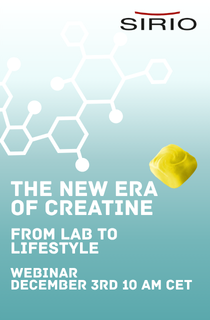Mobile for longer: Active consumers seeking to prevent joint decline early widen target markets
18 Oct 2018 --- The joint and bone health space has moved far beyond encompassing just seniors. Instead, products aimed at mobility are finding audiences as varied as young people to athletes at different levels of training and fields of sports. On top of that, it has expanded to include all mobility-related aspects, such as tendon and muscle health.
Mobility includes products that feature a bone health and/or joint health positioning. Mobility is a significant topic within healthy aging as it concerns a wide range of consumers; from adults to the more senior crowd.

Innova Market Insights data has shown that seven percent of UK consumers used prescription medication for bone health in the past year, while 21 percent used prescription medication for joint health. The market researcher’s data has further shown that mobility is one of the top concerns for UK and US consumers, while products featuring mobility claims accounted for almost 17 percent of all supplements tracked globally between 2013 and 2017.
Opportunities for mobility-related ingredients include glucosamine, collagen, calcium, Vitamin D and even protein.
Suppliers take note
“The market has been evolving from joint health to mobility as a wider concept for a while now,” Alba Soler Conangla, Director of Corporate and Internal Communications at Bioiberica, tells NutritionInsight at CPhI Global in Madrid, Spain.
“That’s why we developed Mobilee which is a product that has efficacy not only in joint health but also in muscle health. This is very important for the overall improvement of mobility.”
“Not only seniors are affected by joint health problems, but also young people, sports people and women in their fifties. They do not like to be seen as seniors, or if they have a condition, they don’t want to emphasize that or be reminded. They feel more comfortable with these supplements rather than drugs,” she adds.
Bioiberica offers b-2cool, an undenatured type II collagen that has demonstrated efficacy in supporting joint health, as well as Mobilee, a patented ingredient with a high concentration of hyaluronic acid (up to 75 percent) and other ingredients such as collagen and polysaccharides that improve mobility.
Innovating in dosages forms
“Another trend is that people prefer low dosage forms and more convenient supplements. This is one of the advantages b-2cool and Mobilee offer; they are efficacious but at very low dosages – 40 to 80 milligrams. Other ingredients may have an effect starting from 1 gram or even 10 grams of hydrolyzed collagen – that’s a whole scoop and it's not convenient,” Monica Gomez Navarro, Product Manager Human Health at Bioiberica, tells NutritionInsight.
“There’s a trend in the market going towards these lower dosages, making these two ingredients very much in line with market trends. There is also a trend of taking fewer pills because they are seen as pharmaceutical,” she says.

fasting growing category for collagen application.
“People want more natural products and having an ingredient effective at a very low dose makes it very suitable for any product format because then you can include it in any food matrix too. If the organoleptic properties of the ingredient are also good, then it’s very convenient for the formulator, as well as the consumer,” Gomez adds.
Also in the mobility space, Rousselot provides Peptan IIm, which contains glycosaminoglycan matrix components (GAGs) and hydrolyzed collagen type II. These are matrix elements similar to those found in human cartilage that support the maintenance of a physically active lifestyle vital for active consumers and athletes.
Speaking with NutritionInsight at CPhI Global, Sara de Pelsmaeker, Product & Business Development Manager at Rousselot, says that it's important consumers start taking joint or mobility health supplements at a relatively early age, possibly before the onset of mobility-related symptoms.
“We are seeing people in their 30s and 40s with a very active lifestyle, who want to continue this when they are 60 or 70 years old. By taking care of their joints now, with food supplements for joint health, they will be able to do that,” de Pelsmaeker says.

senior years. Supplementing for joint and bone health
can help this process.
However, these food supplements can also help those already experiencing bone, joint or muscle issues, making them more mobile than before.
Moreover, the aging population is often already taking a lot of prescribed medication in the form of pills. Since they are not looking to take more medication for joint pain, they seek out natural, healthy food supplements instead, de Pelsmaeker adds.
Where to invest?
“In terms of joint health, convenient dosages, natural ingredients and mobility are the three main market trends,” Gomez concludes.
Further growth can be achieved by educating consumers on the potential benefits of using mobility ingredients before any health issues have arisen, thereby prolonging the possibilities of leading an active lifestyle.
Key here is creating food supplements that do not hone in on the relationship between aging and mobility, but instead are convenient to consume and highlight active lifestyles.
NutritionInsight highlighted UC-II undenatured type II collagen from Lonza in a webinar entitled, “Driving growth in the joint health category: UC-II undenatured type II collagen.”
The collagen ingredient is a once-a-day joint health solution for the joint health market. Its small dose size and mode of action help make it suitable for a range of marketable, joint health solutions. It taps into the trend for low dosage forms, as well as touting natural ingredients and potential for future botanical combinations. View the webinar here.
By Lucy Gunn and Laxmi Haigh
















